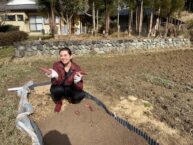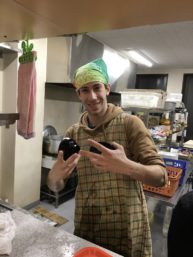For my CIP I practiced Kendo four to six times a week at the Kyoto Butokuden (Martial Arts Center). Overall it was a fantastic experience. The practices themselves were always brilliant, even if I was not. The variety of lessons was so challenging because every night a different Hachidan Sensei (Highest rank attainable) would lead and each had their own styles of teaching and valued different skills. Nonetheless, each Hachidan Sensei maintained a heavy focus on keiko (sparring) at a level of rigor I found to be noticeably higher than in the U.S. I loved this intensity. Everyone at the practice was so focused on improving that the room almost always felt electrified. During matches each person’s desire to win was palpable. Although exciting, this energy was also rather intimidating. The “regulars” had rivalries with other people around their level and had specific Sensei with whom they enjoyed practicing. Also, the established Kendo students more or less knew exactly who they were going to practice with and where to go within the Dojo (practice hall), before practice had even begun. As a new foreigner who knew nothing of the Butokuden etiquette I spent my first week being nicely turned down when I asked to spar someone, and also getting yelled at by sensei for being in the wrong space during basics and drills. Overall, I would describe myself as being rather flustered and confused and in culture shock.
But disorientation slowly dissipated. I began to know which drills were done on which days, which Sensei’s were more open to practicing with newbies and became closer with some of the other foreigners in the community. Near the end of the first month some of the other young adult “regulars” began challenging me during free sparing and I slowly became friends with a couple of them. It was during this time that one of the more notable Nanadan Sensei (second highest rank attainable), Imada Sensei, started hovering around my sparring matches. Finally, after a couple of days of hovering around and silently judging me, he approached and asked (ordered) me to practice with him. Imada Sensei’s sparring session was brutal. He ran me ragged hitting the same basics over and over and every couple minutes asking if I wanted to give up? Every time I would tell him no and push further than I thought possible getting past my earlier urge to give up. He kept me going for a full hour until the final drum sounded signaling the end to the practice. He would simply tell me it was a good practice, let’s spar again tomorrow. It continued like this for about a week where everyday he would run me ragged and just ask me to see him again tomorrow. Finally, at the end of the week he approached me and invited me to come to his personal Dojo (Yubukan) on Sundays. Of course I said yes and after being accepted by one of the most respected Sensei the community opened up. Sensei’s that previously wouldn’t give me the time of day started practicing with me and actually giving me advice. The other foreigners, who I learned a lot of went to Yubukan, began telling me about other Dojos where they practiced and offered to introduce me to their Senseis, so that their Sensei might invite me to practice with them as well.
By the end of the second month of rigorous practice, I received a fantastic opportunity when my friend Yusuke invited me and Tamara, another foreigner I had become close with, to come practice at the Kyoto Police Headquarters with Ito Sensei, one of the few Kyudan Sensei still alive. This level of expertise is no longer available to be earned and after the last of the Kyudan Sensei pass over this level of expertise will enter history. This practice was a blast, but absolutely brutal. Ito Sensei spent a good thirty minutes breaking down Tamara and my basic strikes and having us repeat them over and over commenting on a new error each time and making us do it again. He finally left us and told us to start sparring with the other sensei at the Dojo. I was certain we had disappointed him or failed in some way, but at the end of practice he approached us and asked if he would see us next week at his practice so we could work more on our basics. I was ecstatic and of course said yes. Ito Sensei’s practices became a highlight of my week every week, albeit an often exhausting and painful part of my week as well. Sadly, after only a month of this extraordinary access to a Kyudan Sensei we had to return to America; however, I did get to have one final practice and a send-off party with the friends I made at Kendo.
For any future students at KCJS who want to practice Kendo I have a few pieces of advice. First of all, whether you have practiced before or not, make sure you are really committed to this before you start. In order to be taken seriously and have doors open up for you in the community you really need to give 110%. I saw other foreigners only practice once or twice a week and even though they had been in Kyoto for months or even years longer than me, none of the sensei took them seriously or gave them their full attention. Secondly, if you already have experience, the best thing you can do is just start going to the Butokuden. It is a central space where all the different students at a variety of Dojo’s go in order to practice together. It is a great place both to practice and meet different sensei and players. Finally, if you haven’t practiced Kendo and are starting fresh, it can be hard to find a way into the community. Most people in Japan start Kendo as children so there are few dojo’s that take young adults, let alone young foreigners, on as complete beginners. When I asked around for a friend who was interested in starting to learn Kendo, most sensei recommended my friend join the Doshisha Kendo Circle-which is Not the Kendo Club! The Doshisha Kendo Circle is welcoming to taking on beginners. Unfortunately, unless you are going to KCJS for the Fall semester or full year it could be harder to find a Dojo, since the Doshisha Circle is on break during the Spring semester until mid-March. If you are determined to learn Kendo I recommend you ask your host family or the KCJS office if they have any connections they can call on your behalf. In my opinion, it is worth persevering since once you have that connection and find a Dojo, the Kendo Community becomes a wonderful and welcoming place that will enhance your experience as an exchange student in Kyoto.


